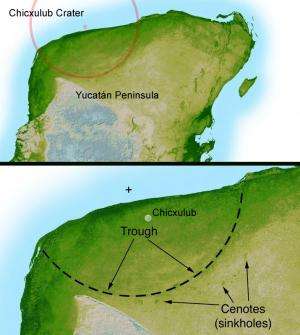May 13, 2014 report
Researchers find proof of global cooling after Chicxulub asteroid impact

(Phys.org) —Scientists have long believed an asteroid that collided with the Earth around 66 million years ago, leaving an enormous crater near Chicxulub Mexico, caused the demise of the dinosaurs and many other living things. Ash and dust thrown into the air during the impact would have caused darkness and a drop in global temperature, leading to a mass extinction. Johan Vellekoop of Utrecht University in the Netherlands and his colleagues have found evidence of this global cooling by studying lipids in sediment formed at the same time as the collision. The research appears in the Proceedings of the National Academy of Sciences.
The Cretaceous-Paleogene (K-Pg) extinction event was one of the largest mass extinctions on Earth. A 180-kilometer-wide impact crater near the town of Chicxulub, in Mexico's Yucatan peninsula, is evidence of the asteroid impact believed to have caused it. While proof of the collision exists, until now, scientists have found no evidence of an impact winter occurring afterward. This could be because the period of global cooling was very brief, lasting from months to decades. In addition, many of the algae that produce the chalky fossils used to study ocean surface temperatures became extinct themselves.
Vellekoop and his team looked for signs of global cooling in sediment at the Brazos River in Texas. There, layers of sediment formed at the K-Pg boundary contain high levels of iridium, which would have come from the asteroid. These layers contain many broken shells, which could have been remnants of a tsunami caused by the impact.
The researchers studied lipids produced by the microbe Thaumarchaeota. The composition of these lipids changes as ocean temperatures change. An examination of lipids preserved in sediment at the K-Pg boundary revealed that after the impact, ocean temperatures fell an average of two degrees Celsius, with drops of up to seven degrees Celsius in some places. This decrease in temperature lasted up to several decades, a timescale supported by models and by evidence of species migration.
The sudden cooling would have caused a great amount of stress on living things and therefore been a key contributor to the mass extinction. When dust injected into the atmosphere rained out, the ocean surfaces would have become acidic, resulting in yet more stress for surface-dwelling organisms.
Vellekoop's team found that a stable warm period followed this short period of global cooling. Large-scale mortality, forest fires and the vaporization of rock would have released greenhouse gases into the atmosphere, causing this global warming. The team thinks the research should help increase understanding of the effects of rapid climate change.
More information: Johan Vellekoop, Appy Sluijs, Jan Smit, Stefan Schouten, Johan W. H. Weijers, Jaap S. Sinninghe Damsté, and Henk Brinkhuis. "Rapid short-term cooling following the Chicxulub impact at the Cretaceous–Paleogene boundary." PNAS 2014 ; published ahead of print May 12, 2014, doi:10.1073/pnas.1319253111
Abstract
The mass extinction at the Cretaceous–Paleogene boundary, ∼66 Ma, is thought to be caused by the impact of an asteroid at Chicxulub, present-day Mexico. Although the precise mechanisms that led to this mass extinction remain enigmatic, most postulated scenarios involve a short-lived global cooling, a so-called "impact winter" phase. Here we document a major decline in sea surface temperature during the first months to decades following the impact event, using TEX86 paleothermometry of sediments from the Brazos River section, Texas. We interpret this cold spell to reflect, to our knowledge, the first direct evidence for the effects of the formation of dust and aerosols by the impact and their injection in the stratosphere, blocking incoming solar radiation. This impact winter was likely a major driver of mass extinction because of the resulting global decimation of marine and continental photosynthesis.
Journal information: Proceedings of the National Academy of Sciences
© 2014 Phys.org



















